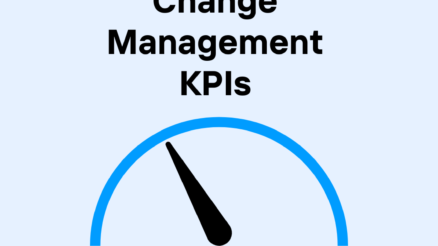Have you ever wondered what sets successful organizational change initiatives apart from those that struggle to gain traction?
The answer often lies in the artful development of a change management sponsorship plan.
In the ever-evolving landscape of businesses, the role of effective sponsorship cannot be overstated.
This blog post is your guide to understanding, implementing, and optimizing a change management sponsorship plan that acts as the linchpin for transformative success.
Join us on a journey through the intricacies of change management sponsorship as we explore the critical components and proven strategies that empower leaders to champion change and drive lasting impact within their organizations.
What is Change Management?
Change Management is a systematic and structured approach to transitioning individuals, teams, and organizations from their current state to a desired future state.
It is a multidisciplinary field that incorporates processes, tools, and techniques to manage the human side of change, ensuring that people are ready, willing, and able to adopt new ways of working or embrace organizational transformations.
The primary goal of change management is to minimize resistance and maximize the successful adoption of changes, ultimately contributing to the achievement of organizational objectives.
This discipline encompasses various elements, including communication, stakeholder engagement, training, and leadership, all working in tandem to facilitate a smooth and effective transition during periods of organizational change or development.
What is Change Management Sponsorship?
Change management sponsorship refers to the crucial role played by influential and supportive leaders within an organization during times of change.
In the context of change management, a sponsor is typically a senior executive or leader who champions and advocates for the proposed changes, guiding the organization through the transition.
The sponsorship role involves providing visible support, communicating the vision for change, and actively participating in key change management activities.
Change management sponsorship is essential for the success of any change initiative because sponsors help create a sense of urgency, align the organization’s leadership, and address resistance.
Effective sponsors not only endorse the need for change but also commit resources, time, and energy to ensure the initiative’s success.
They act as a bridge between the change management team and the rest of the organization, reinforcing the importance of the change and motivating employees to embrace the new direction.
Importance of Change Management Sponsorship
Change management sponsorship holds immense importance in the success of organizational change initiatives. Here are key reasons why effective sponsorship is crucial:
Leadership Alignment
Change management sponsorship ensures that top leadership is aligned with the goals and objectives of the change initiative. When leaders actively support and endorse the change, it sends a powerful message throughout the organization, fostering unity and a shared vision.
Overcoming Resistance
Resistance to change is a common challenge in organizations. Sponsors, by leveraging their authority and influence, can address and overcome resistance more effectively. Their visible commitment helps build trust and encourages employees to embrace the changes with confidence.
Resource Allocation
Sponsors play a pivotal role in allocating necessary resources, whether they be financial, technological, or human. This support is vital for the successful implementation of change initiatives, ensuring that teams have the tools and resources needed to navigate the transition.
Communication and Motivation
Effective sponsors are skilled communicators who can articulate the reasons behind the change, the benefits it brings, and the expected outcomes. Their communication efforts motivate employees, providing a clear understanding of the vision and fostering a sense of purpose among the workforce.
Visibility and Credibility
Sponsors bring visibility and credibility to the change process. Employees are more likely to commit to changes when they see that top leadership is actively involved and committed. This involvement enhances the credibility of the change initiative and the leadership team.
Problem Solving and Decision-Making
Sponsors are well-positioned to address challenges and make crucial decisions during the change process. Their involvement ensures that obstacles are identified and resolved promptly, preventing potential roadblocks that could impede the progress of the initiative.
Sustaining Momentum
Change initiatives require sustained momentum for long-term success. Sponsors are instrumental in maintaining the momentum by continually reinforcing the importance of the changes and celebrating milestones and achievements along the way.
Organizational Culture Impact
The behavior and actions of sponsors significantly influence organizational culture. Positive sponsorship promotes a culture that embraces change, innovation, and continuous improvement, fostering an environment where adaptability is valued.
12 key components of change management sponsorship plan
A comprehensive change management sponsorship plan involves several key components to ensure effective leadership and support throughout the change process.
Here are essential elements to include in a change management sponsorship plan:
1. Sponsor Identification and Roles
Sponsor identification and roles are foundational aspects of a change management sponsorship plan.
In this process, key individuals within the organization are identified as sponsors, typically senior executives or influential leaders who will champion and actively support the change initiative.
Each sponsor is assigned specific roles and responsibilities, which may include communicating the vision for change, addressing resistance, allocating resources, and advocating for the initiative at the leadership level.
The identification of sponsors ensures a clear line of authority and commitment, while well-defined roles guide sponsors in their contributions to the change process.
This collaborative and strategic approach lays the groundwork for building a strong sponsorship coalition capable of driving successful organizational transformations.
2. Stakeholder Analysis
Stakeholder analysis is a critical component of Change Management Sponsorship Plans, involving the systematic identification and assessment of individuals, groups, or entities affected by or influencing the change initiative.
In this process, stakeholders are categorized based on their level of interest and influence, allowing for a targeted and tailored approach to sponsorship strategies.
High-influence stakeholders with significant interest are often prioritized for focused communication and engagement efforts, while strategies for managing resistance or garnering support are customized based on stakeholder characteristics.
Stakeholder analysis provides invaluable insights that guide sponsors in navigating the complexities of organizational change, ensuring a more effective and inclusive approach that considers the diverse perspectives and needs of those impacted by the change.
3. Communication Strategy
A communication strategy is a pivotal component of a change management sponsorship plan, encompassing a systematic plan for conveying key messages related to the change initiative.
This strategy involves defining the purpose, audience, content, and channels for communication, ensuring that the information is effectively disseminated throughout the organization.
A well-crafted communication strategy is tailored to various stakeholder groups, acknowledging their unique needs and concerns.
It aims to create a shared understanding of the change, articulate the benefits, and address potential challenges or uncertainties.
Clear and consistent messaging helps build trust, fosters employee engagement, and reinforces the commitment of sponsors to guide the organization through the change process.
4. Training and Development
Training and development within the context of a Change Management Sponsorship Plan involve the deliberate efforts to equip sponsors and key leaders with the necessary knowledge, skills, and tools to effectively navigate and champion the organizational change.
This component focuses on enhancing the capabilities of sponsors, ensuring they possess a deep understanding of change management principles, communication techniques, and strategies for addressing resistance.
Training may cover various aspects, including the specifics of the change initiative, leadership responsibilities, and methods for fostering a positive and adaptive organizational culture.
5. Alignment with Organizational Goals
Alignment with organizational goals is a fundamental aspect of a Change Management Sponsorship Plan, emphasizing the integration of the change initiative with the broader strategic objectives of the organization.
This component ensures that the proposed changes contribute directly to the overarching mission, vision, and goals of the company.
Effective sponsorship requires a clear understanding of how the change aligns with the organization’s long-term strategy, values, and desired outcomes.
This strategic connection helps build a stronger foundation for the change initiative, positioning it as an integral part of the organization’s overall success and sustainability.
6. Resource Commitment
Resource commitment is a pivotal aspect of a change management sponsorship plan, signifying the explicit dedication of essential resources by sponsors to ensure the successful implementation of a change initiative.
These resources encompass financial investments, human capital, technological support, and any other necessary assets vital for the change process.
The commitment of resources by sponsors not only demonstrates the importance placed on the change initiative but also ensures that the change management team and employees have the necessary tools and support to navigate the transition effectively.
This commitment is a tangible expression of leadership’s endorsement and active involvement in the change, playing a crucial role in overcoming obstacles, addressing challenges, and fostering an environment conducive to sustained organizational growth and development.
7. Metrics and Key Performance Indicators (KPIs)
Metrics and Key Performance Indicators (KPIs) are integral components of a change management sponsorship plan, providing a structured framework to assess the success and impact of a change initiative.
By defining specific, measurable metrics and KPIs, sponsors can objectively evaluate the progress of the change, track milestones, and gauge the effectiveness of the implemented strategies.
These performance indicators may include employee engagement levels, adoption rates of new processes or technologies, reduction in resistance, or improvements in overall organizational performance.
Establishing clear metrics and KPIs not only enables sponsors to demonstrate the tangible outcomes of the change but also facilitates informed decision-making, allowing adjustments to be made in real-time to ensure the initiative aligns with organizational objectives and delivers the desired results.
8. Risk Assessment and Mitigation
Risk assessment and mitigation are crucial components within a change management sponsorship plan, involving the systematic identification, analysis, and proactive management of potential challenges or obstacles that may impede the success of a change initiative.
In this process, sponsors collaboratively assess risks associated with the change, considering factors such as resistance from employees, lack of stakeholder engagement, or unforeseen external factors.
Once identified, strategies for mitigating these risks are developed to minimize their impact on the change process.
The aim is to enhance the organization’s resilience and adaptability by proactively addressing issues before they escalate, allowing sponsors to navigate the complexities of change more effectively and ensuring a smoother transition toward the desired future state.
9. Recognition and Celebration
Recognition and celebration are vital components of a change management sponsorship plan, emphasizing the importance of acknowledging and rewarding achievements and milestones throughout the change initiative.
By actively recognizing and celebrating the efforts and successes of individuals and teams involved in the change process, sponsors contribute to a positive and motivating organizational culture.
This component not only boosts morale but also reinforces the value of the change, encouraging continued commitment and engagement.
Celebrations can take various forms, from public acknowledgments and appreciation events to tangible rewards and incentives, creating a sense of accomplishment and unity among employees.
Recognition and celebration serve as powerful tools for sustaining momentum, fostering a supportive environment, and reinforcing the notion that the organization values the dedication and resilience displayed during the challenging phases of change.
10. Continuous Feedback Mechanism
A continuous feedback mechanism is a critical element of a change management sponsorship plan, involving the systematic collection and incorporation of feedback throughout the change process.
This component creates an ongoing dialogue between sponsors, the change management team, and stakeholders, allowing for real-time adjustments and improvements.
By actively seeking and responding to feedback, sponsors can address concerns, identify emerging issues, and adapt strategies to better meet the evolving needs of the organization.
This dynamic feedback loop not only enhances the effectiveness of the change initiative but also promotes a culture of transparency, trust, and collaboration.
It ensures that the sponsorship plan remains responsive and agile, fostering a resilient approach to change that aligns with the organization’s goals and the expectations of its workforce.
11. Change Agent Network
The Change Agent Network is a strategic element within a change management sponsorship plan, encompassing a group of individuals designated as change agents or champions who collaborate closely with sponsors to facilitate the successful implementation of a change initiative.
These change agents act as advocates and influencers at various levels of the organization, promoting the goals and benefits of the change among their peers and teams.
The Change Agent Network helps amplify the impact of sponsorship efforts by creating a grassroots movement that supports and reinforces the key messages and objectives of the change initiative.
These individuals often play a crucial role in disseminating information, addressing concerns, and fostering a positive attitude toward the change, contributing to a more inclusive and collaborative change environment within the organization.
12. Timeline and Milestones
The timeline and milestones component of a change management sponsorship plan involves the strategic delineation of the change initiative’s key phases, deadlines, and achievements.
This element provides a structured roadmap for sponsors and stakeholders, outlining the sequence of activities and expected progress over time.
By establishing a timeline with clear milestones, sponsors can set realistic expectations, track the advancement of the change initiative, and ensure that the overall project stays on course.
Milestones serve as crucial markers, signifying the completion of significant tasks or the attainment of specific goals, thereby allowing for timely assessment, adjustments, and celebrations.
This component not only aids in project management but also provides a visual guide for sponsors, stakeholders, and the broader organization, fostering transparency and a shared understanding of the change journey.
Final Words
The success of organizational change hinges on the meticulous design and execution of a well-crafted change management sponsorship plan. This strategic framework, with its interconnected components such as stakeholder analysis, resource commitment, and continuous feedback mechanisms, serves as the linchpin for effective leadership during transformative journeys. As organizations evolve, the change management sponsorship plan remains not only a guide but a dynamic and responsive tool, ensuring that change initiatives not only succeed but thrive, fostering a culture of innovation and continuous improvement within the ever-changing landscape of modern businesses.



